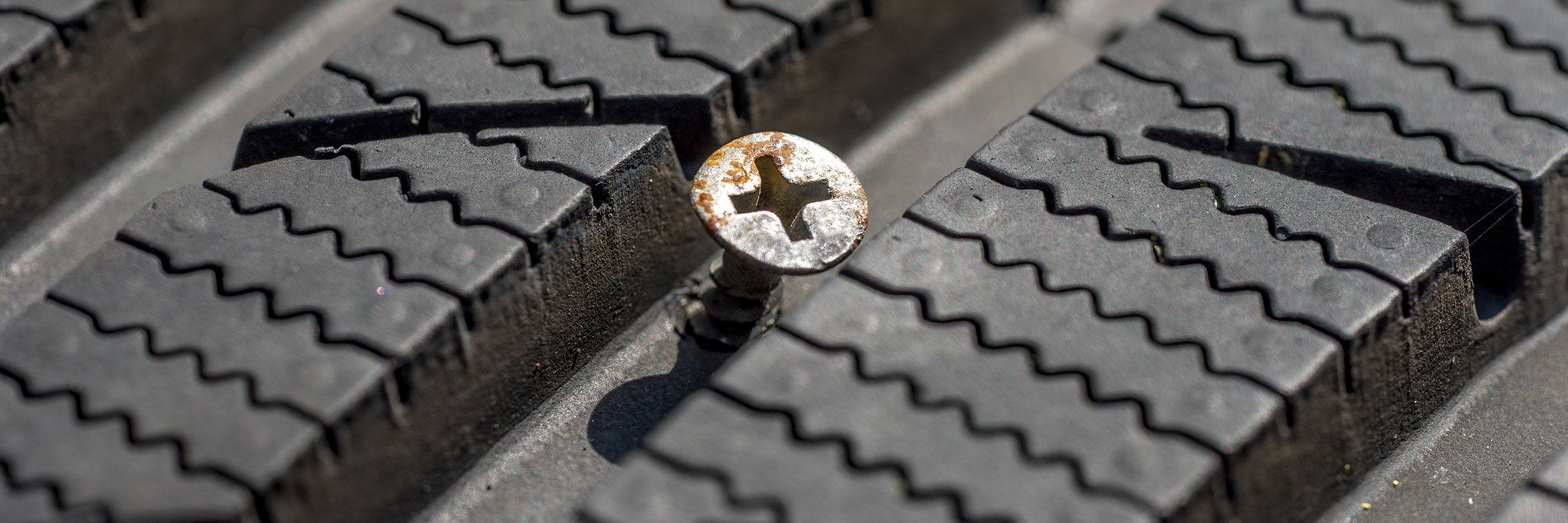
# Tire Damages and Age
Tire repair
What you can and cannot repair on a flat tire
Okay, so you’ve got yourself a puncture in one or more of your tires. It can happen. Tire repair is an option to explore rather than buying a brand-new tire, but drivers should know the full extent of what is legally permissible to have fixed.
The law in most countries has a strict definition as to the classification of repair materials, and the number of repairs permitted on a single tire. Regulations like these are necessary to ensure safety for all road users.
In summary, tire repair work is not permissible when:
- The tread depth is lower than the 1.6 mm legal limit;
- The structural integrity of the tire has been compromised or there is run flat damage;
- The rubber is cracked, worn, or deteriorated;
- There’s damage caused by an external object;
- The cords are exposed;
- There’s any sign of faulty repairs made in the past.
The precise location of the puncture is also a deciding factor. The rules stipulate that tire repairs must stay within the central three-quarters of the tread, known as the “minor repair area.”
Moreover, if the size of the puncture is more than or equal to 6 mm in diameter, a repair isn’t permitted at all. Drivers have no other alternative than to invest in a brand-new tire.

Are punctures in the sidewall repairable?
In a word, no. More specifically, a puncture that falls outside the minor repair area is not eligible for fixing because of its proximity to the sidewall.
The sidewall is off limits for a straightforward reason. When the tire is in daily operation, this section undergoes a significant amount of stress. Any attempts at making repairs in this area will potentially weaken the structural integrity of the tire.
Another factor is that the sidewall experiences the most flex in the tire. It’s unlikely that a repair patch applied here will stay in place for very long, and the tire will fail once again.
One more thing concerning the sidewall is that you should avoid driving any further on a flat tire if you hope to salvage it. Inflation pressure maintains the shape of the tire while driving; when that pressure is lost, the tire sidewall is going to be pinched between the wheel rim and the road, so continuing to drive will extend the damage beyond the minor repair area.
In other words, do not drive on a deflated tire while the puncture is within the minor repair area (and is therefore repairable). The tire sidewall could sustain additional damage that renders it beyond repair. The better course of action is to have the vehicle towed or swap the punctured tire out for the spare tire until you reach the nearest garage.
Related content
-
 2024/10/17Replacing tiresHow long will tires last before you should replace them? It depends on the tread design of the tire, road conditions, and how frequently the car is in use.Read more
2024/10/17Replacing tiresHow long will tires last before you should replace them? It depends on the tread design of the tire, road conditions, and how frequently the car is in use.Read more -
 2024/10/17Tire damagesTires can become damaged, and it can happen without the driver realizing there's an issue. We explain the signs and symptoms to help diagnose the problem.Read more
2024/10/17Tire damagesTires can become damaged, and it can happen without the driver realizing there's an issue. We explain the signs and symptoms to help diagnose the problem.Read more -
 2024/10/17Disposing of tiresWhen you're ready to dispose of your old tires, it's time to recycle them. Many tire dealers will recycle your scrap tires for you when buying a new set.Read more
2024/10/17Disposing of tiresWhen you're ready to dispose of your old tires, it's time to recycle them. Many tire dealers will recycle your scrap tires for you when buying a new set.Read more
